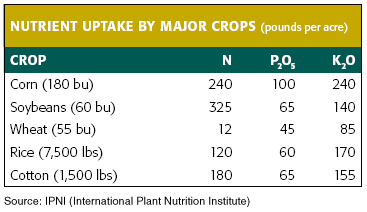

Mosaic's chief agronomic leader, Dean Fairchild, knows that science is on our side when it comes to solving the world's long-term food needs. With nearly four decades' experience as an agronomist, Dean explains the science behind how crop nutrient application can help farmers dramatically increase their crop yield.
Potassium, along with nitrogen and phosphorus, is one of three essential primary nutrients for plants. Why is potassium critical to plant growth?
With the exception of nitrogen, it's not surprising that plants need more potassium than any other nutrient, considering the large role this nutrient plays in plant growth. We think of potassium as "the regulator" because it facilitates many essential processes — enzyme activation, photosynthesis and starch formation, to name a few. The formation of large, deep root systems, reduced water loss and wilting, and increased yields are among the direct benefits of potassium.
Is phosphorous as important as potassium?
Absolutely. There is no substitute for phosphorus, which plays a key role in photosynthesis that converts the sun's energy into food. This is why phosphorous is known as "the energizer." It helps improve root growth and improves overall crop quality and yield.

Do all crops have the same nutritional requirements?
All crops require the same nutrients, but uptake varies greatly. For example, corn requires high amounts of nitrogen, phosphorous and potassium. If you compare the standard market units for corn and cotton, the difference is striking.
Doesn't the soil supply some of these nutrients?
Yes, but all soils are not created equally, and all crops do not consume equal quantities of nutrients. This is why understanding agronomy is so important. Routine soil analysis reveals the level of available nutrients in the soil. Soil test nutrient levels are analyzed with other factors such as yield potential, crop prices and moisture availability to determine how much of each nutrient should be applied as fertilizer.
Is timing a factor when applying crop fertilizers?
Very much so. At Mosaic, we focus on placing the right product with the right placement at the right time and at the right rate. On average, a corn plant uses approximately 30% of total phosphorous and more than 50% of total potassium in the first 50 days. Generally, phosphorous is required in larger quantities through maturity.

When a farmer decides to reduce or forego nutrient applications, how long before there is an effect on yield?
The level of yield at risk depends on how well the farmer has cared for the soil in the past. Some farmers apply extra amounts of phosphorous and potassium every season, and this buildup will last a season or two. But with every harvest the soil is further depleted of nutrients. Sooner or later, a properly balanced blend of nutrients must be applied in order to restore yields to optimal levels.
Is it possible to quantify the effect on yield when nutrients are not applied?
Thanks to years of study on research plots we have an understanding of the critical level of phosphorous and potassium necessary to provide optimal soil conditions. A field testing low-to- medium phosphorous levels would be expected to yield only 80% of a comparable field that was above the critical level. Likewise, low-to-medium levels of potassium would result in a yield of only 85%.
Mosaic encourages balanced plant nutrition. Why is this important?
In agronomy, the "Law of the Minimum" is in effect. If just one essential plant nutrient is deficient and all other essential nutrients are adequate, plant growth will suffer. The growing process is a series of complex chemical and plant interactions. When even one part of the equation is out of balance, it will have a domino-like effect on yield. When crop nutrient prices are high, there can be a tendency to reduce one nutrient in favor of a less expensive one. Unfortunately, soil chemistry is not that simple.






